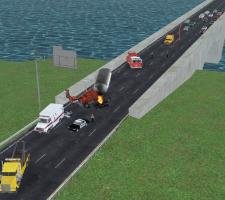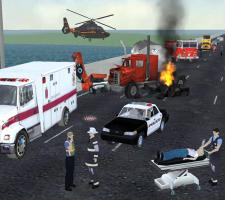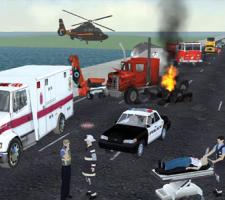
I-95 Corridor Coalition's Tom Martin discusses the state of the art in incident management and what visitors to this year's ITS World Congress can expect of the first ever Emergency Responder-Incident Management Day
Developments in incident management are driven in the main by need. A bald statement, and one which holds no surprises, it nevertheless quantifies the evolutionary process within the I-95 Corridor Coalition over the last decade and more.
Spread over 16 states from Maine to Florida, the Coalition's first efforts to reach some form of consensus on incident management were unfunded, informal affairs and participation was on a voluntary basis. Since then, with the aid of
Tom Martin, formerly of the
"The numbers of vehicles on our roads have grown tremendously. With that has come an increase in the numbers of secondary accidents. Around a fifth of all accidents are as a result of another which has already occurred. That made it essential to assess how to do things better and smarter; improving clearance times of even the most minor incidents has been a major focus recently. Safety, unsurprisingly, has also been a big topic of interest. In incident management terms, there's a three-pronged approach involving the responder, those involved in the accident or incident, and other motorists."
Best practice
"It'd be too much to state that was the Coalition currently does represents absolute best practice, however.
"There are a lot of examples out there of some extremely valid work and we'll readily steal a good idea from somewhere else. We'll also happily share our own; the I-95 Corridor Coalition addresses what goes on up and down the East Coast and with a mix of both heavily populated and heavily rural constituencies it provides a real mix of operating conditions and expertise. But a lot of very good work has also gone on in California and in many places in between. There are pockets of excellence where we see very positive support from first responders and politicians and, just as important, funding to back this up. At the same time there are places which are not so good, whether because of the economy or political motivations.
"At the regional level, I'd say the Delaware Valley has been extremely successful in bringing together over 40 stakeholders and gaining agreement on protocols for incident management. At the state level, Indiana has come up with some very solid legislation to deal with civil liability issues. In doing so, it has addressed the timidity with which some first responders approach incident clearance."
Technology
"In terms of the use of ITS, how it affects the state of the art depends greatly on the extent of deployment and this varies greatly from corridor to corridor. The key is the appropriate use of technology, be it for signalisation operation, deconfliction of emergency vehicles approaching intersections, incident detection - and we've seen huge proliferation in the use of cameras, the correct messages to display on Variable Message Signs ["One of the biggest issues with technology at present is that there are so many proprietary systems out there. The lack of standardisation means that communication from TMC to TMC is often difficult.
"Another problem is that the pace of technological development is far outstripping our ability to fund and field it. Look at NG911, for instance. We have a population, an increasing number of whom carry smart phones. That means a significant and growing number of members of the general public have the ability to text notification of an incident to a despatch centre. They can even take snapshots of an incident - which can be 'fixed' using GPS - and send these on to allow verification and assessment of the severity of what's occurring. In both cases, though, despatch centres don't currently have the ability to accept or process such messages.
"NG911 is trying to address such shortcomings but the issues in many cases are funding-related: who's going to pay for despatch centre fit-out and then the training and on-going costs of the necessary staff? I don't think that incident management is a neglected area, necessarily; I think we'll get there in terms of implementing such improvements but I also think we need to prioritise things more. In general incident management is felt to be a priority but that priority isn't always realised despite the talk.
"Any changes need to be championed, however, and it's good that NG911 does have its champions. At the national level, the
I-95 Corridor Coalition has participated in work supported by the Transportation Safety Advocacy Group (TSAG) and
Standards
"Across the US, standardisation needs tremendous amounts of attention. Even before you get to the more specialised technologies and systems which can improve emergency responses we have to address issues pertaining to the fundamentals. From state to state, for instance, we can't even agree on whether the light bars on responders' vehicles should be red, red and blue, or something else. Overall vehicle standards vary widely; we don't even have standards on such basics as traffic cones."Becoming slightly more sophisticated, what messages do we display on VMS... time, distance or some other information? The I-95 Corridor Coalition with the FHWA is attempting to create a standard traffic incident management training course which would go a long way to addressing responder issues. Again, though, participation is voluntary.
"We do look abroad to see what best practice is in other countries. For instance, across the UK police and emergency response vehicles are distinguished by highly visible 'Battenberg' reflective markings. We're seeing little pockets of the US where some jurisdictions are following suit. Again, though, we're also seeing push-back where form triumphs over function and, ultimately, safety."
World Congress showcase
Just how far the topic has progressed is reflected in the inclusion this year at the"This is the first of its kind and still very much work in progress but attendance will be free of charge to all emergency responders," Martin continues. "It will be a venue for instruction, sharing best practice and demonstrating equipment. The emphasis will be on networking." One new solution which will be prominently showcased is a new 3D training aid which has been developed by the I-95 Corridor Coalition with FHWA backing. This is based on the types of multi-player computer gaming systems which have already been adapted and adopted by other users such as the military to improve levels of competency while reducing the huge logistics burdens and costs associated with major field exercises.
"It's important that we address the issues of training, consistency of response and core competencies," Martin explains. "Large-level training drains resources not just because of the training itself but also because of the operational backfill which has to be somehow provided.
"The new 3D training system addresses the evolution in learning which we've seen in recent years; people are much more used to doing things online than they used to be.
"We wanted an interactive training programme which would allow people to log on from wherever they are and through a facilitator be assigned an avatar and a role, such as law enforcement or emergency medical service. Everything is recorded and critiqued with the emphasis on, 'How did you respond?' "There are also some artificial intelligence elements. So, for instance, if you're an emergency responder and you get out of your vehicle without your high-visibility jacket on, within three minutes the computer will ensure that you're hit by a passing vehicle. Immediately, that catapults you into another scenario.
"Flexibility is a big draw, in that users can very readily learn others' roles. In old-fashioned table-top exercises, for example, it was common for policemen to remain policemen, firemen to remain firemen and so on. With this system, users can take on or be allocated other responsibilities." The new training system has been developed over a two-year period in conjunction with the University of Maryland and at a cost thus far of over $1 million; Martin notes that with no comparable system on the market, they had to start from scratch.
"Our first pilot training programme took place in the fall of last year and since then we've had a total of four. We've learned something new on each one. Next, we're going to be preparing an online version which will allow users to go through core competencies individually.
"What the end game for all this will be, I don't know - it's still too early to tell. We're hoping that the whole idea will prove attractive to emergency responders. From there, there's the potential for national use. It could well become the driver for national standards which we've been looking for. It'd be tremendous to see that happen but it very much depends on user reception."














